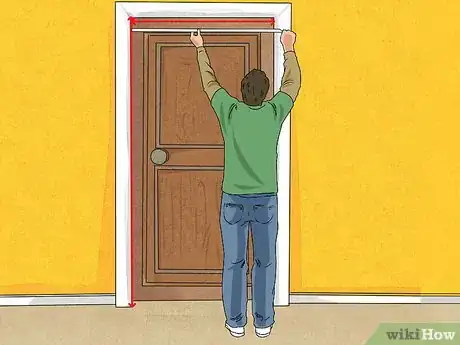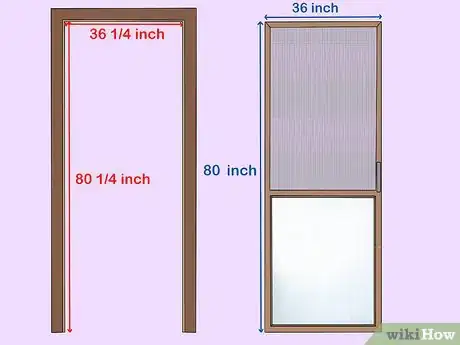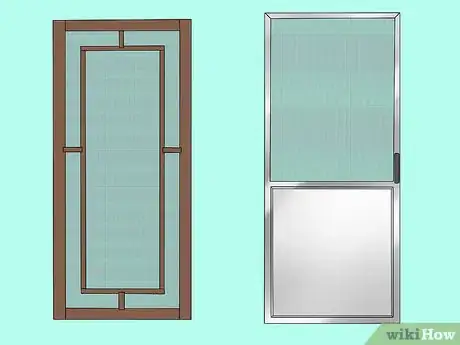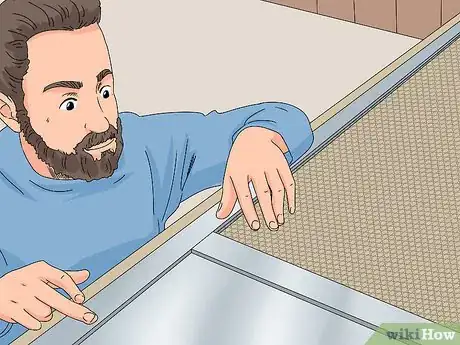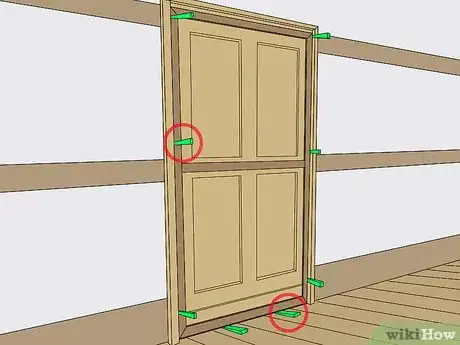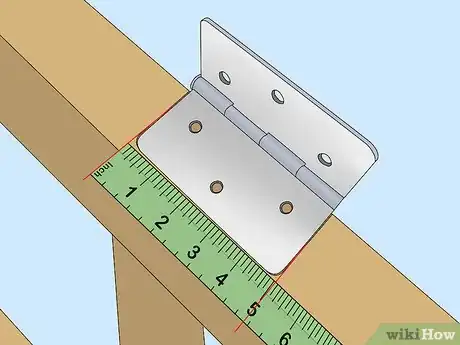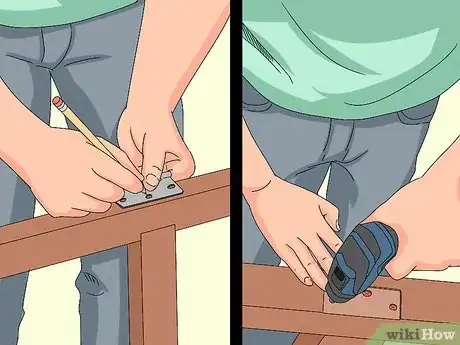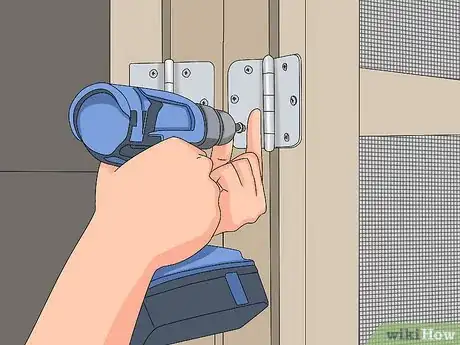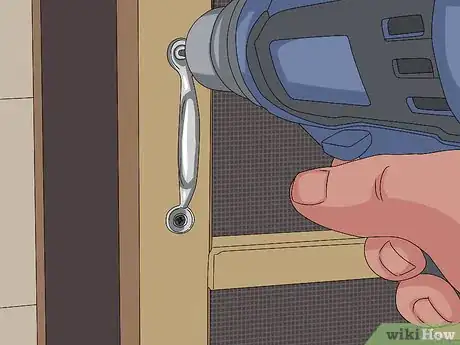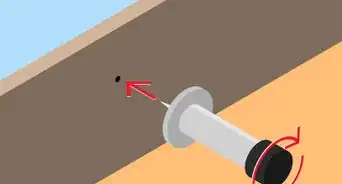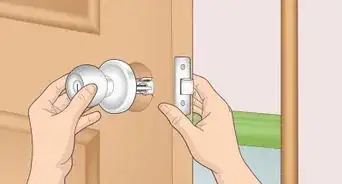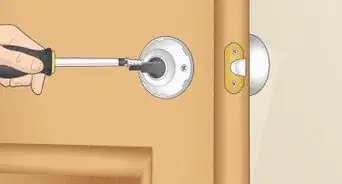This article was co-authored by wikiHow Staff. Our trained team of editors and researchers validate articles for accuracy and comprehensiveness. wikiHow's Content Management Team carefully monitors the work from our editorial staff to ensure that each article is backed by trusted research and meets our high quality standards.
wikiHow marks an article as reader-approved once it receives enough positive feedback. This article received 13 testimonials and 82% of readers who voted found it helpful, earning it our reader-approved status.
This article has been viewed 457,170 times.
Learn more...
A screen door can spruce up a simple entryway and serve as a practical addition to your home. It will offer minor protection to your door from the elements during the colder months, and allow you to let in some fresh air during the warmer months. You may think that you have to hire a professional to install one, but you don’t. As long as you correctly measure the door frame and acquire the necessary tools, you will be able to properly install a screen door in no time.
Steps
Selecting a Screen Door
-
1Measure the outside of the door frame. Not all door frames will be perfectly square, so to account for this, take the length and width measurements along the top, middle, and bottom portions of the frame. Think of these measurements like a grid across the opening of your door.[1]
- The average door height is usually 80 inches (200 cm), and some standard widths are 36 inches (91 cm), 32 inches (81 cm), and 30 inches (76 cm). Your door frame will most likely measure a little bit more than one of those standard door sizes.
- If you have to use a tall step stool or ladder to take these measurements, or for any other part during the installation process, have someone hold the stool or ladder in place. It is dangerous to work on a ladder without someone to help you.[2]
-
2Subtract 1⁄4 in (0.64 cm) from the shortest length and width measurements. You need at least a 1⁄8 inch (0.32 cm) gap around the entirety of the door to ensure that it will fit properly. Using the shortest length and width will take into account that the door frame might not be perfectly square.[3]
- If your door frame is 80 and 1⁄4 inch (203.20 and 0.64 cm) tall and 36 and 1⁄4 inch (91.44 and 0.64 cm) wide, look for a door that is 80 inches (200 cm) tall and 36 inches (91 cm) wide.
Advertisement -
3Choose a style that will complement the exterior of your house. Screen doors are often the focal points to front and side entries of homes. Choose a material, color, and style that will best accent your home. The most common ones are made of wood, but there are aluminum and vinyl screen doors as well. A wide selection of these options can be found either online or at your local home improvement or hardware store.[4]
- Unfinished pine screen doors are great to have when working on a tight budget. The average door will cost around $30.00 USD (25.49 Euros). The simple design and unfinished wood will give you the option to stain or paint it whatever color you desire. Choose a classic white trim, a rustic stain, or a bold paint color that will contrast traditional siding. If you decide to paint the door, use exterior paint so it can withstand the elements.
- Vinyl and aluminum screen doors are simple and easy to install. These are offered in standard, neutral colors and shades, and will not require you to paint them before installing. The starting price for these doors typically start at $50.00 (42.48 Euros) and increase from there between brands.
- Look for screen doors that break away from traditional models by purchasing one made of hardwood or one that has a unique design. Either of these types of screen doors will make an excellent statement piece for the front of your home. The starting costs for these designs can vary greatly, but at most you may pay $200.00 (169.93 Euros).
-
4Decide on a screen material if the option is available. Some manufacturers will allow you to select a material to make your screen out of. The common choices are often between a plastic mesh, metal mesh, iron screen, or solid metal screen.[5]
- Plastic and metal meshes are the most common screen materials due to the affordable pricing, but can tear easily.
- Iron and solid metal screens are durable enough to withstand a pet accidentally jumping on it, but these options can be pricey.
-
5Check the screen door for any damages to the frame or screen. Since you most likely had to order the door at a local home improvement or hardware store, check that it is in good condition before you proceed with installing it. Look for any noticeable dents or dings in the framing as this could compromise the integrity of the door. Closely examine the screen for any tears or manufacturing defects that would allow bugs and other small critters to crawl through.[6]
- Proceed with the installation process if you don’t find anything wrong with the screen door. If you do find something wrong, speak with a representative at the store you ordered it from about returning or exchanging the item.
Hanging the Screen Door
-
1Decide which direction the door will open. Generally, the handle for the screen door should be on the same side as the handle for your main door. However, if the handles will interfere with each other or if the screen door will open and hit an object, have it open in the other direction.[7]
-
2Have someone help you safely put the screen door in the door frame. Even though the screen door may not be heavy to lift and hold in place, you need to have your hands free to properly secure and install it. Recruit a willing family member or friend to just gently apply pressure on the screen door so it does not fall forward.[8]
- If you do not have someone who can hold the door in place, remove the door once you have confirmed it fits. It is easier to attach the hinges to the door when it is not in the door frame when you are working by yourself.[9]
-
3Wedge shims between the door and the frame to check that it fits. Shims are thin, tapered items that are used as spacers. Place at least 1 shim along the top and bottom of the door, and 2 shims on each side. This is an easy way to double-check that there is the needed 1⁄8 inch (0.32 cm) gap around the entire door.[10]
- If the shims cannot be inserted, this means that portions of your door frame are not square. For minor adjustments, lightly sand the screen door if it is wood, or sand the wooden frame until it fits.[11]
- If both your door and frame are not made of wood, have a professional safely square the frame and finish installing the door.[12]
-
4Measure the placements for the 3 hinges along the length of the door. The hinges will be on the opposite side of the door from the handle. Make marks along the edge of the door that are 5 inches (13 cm) from the top and bottom. This is where the upper and lower hinges will be placed. The last hinge will be placed centrally to the first 2 marks.[13]
- Alternatively, to avoid measuring for the hinges, align them to match the hinges on the inside door. This works best if the screen door and the inside door have the same dimensions.[14]
- Use a pencil to make marks on the door so they can be easily washed off.
-
5Use a hinge as a template on the door and drill pilot holes for the screws. Align the hinge with the measured marks you made on the door. This will ensure that you drill the needed holes in the proper place on the door.[15]
- Drill the necessary number of pilot holes needed for each of the 3 hinges in the marked areas on the door.
-
6Use a drill to install the mounting screws into the pilot holes. Slowly install the screws until the hinge is firmly pressed against the door; otherwise, you might cause the hinge to twist or fall out of place. There will most likely be 3 mounting screws per hinge, so try and start with the middle hole on the hinge to ground it, and then the outer ones.[16]
- Only use the hardware that came with the screen door as those pieces will work best for hanging it.
- Repeat this process until all 3 hinges are properly secured to the door.
-
7Attach the hinges to the door frame. With the door being held in place, use your drill to secure the hinges to the adjoining door frame. Start by making starter holes, using the attached hinges as a guide, and then install the mounting screws.[17]
- Since you have already properly mounted the hinges to the door and have the door properly spaced with shims you should not have to do any measuring for this part. However, you may want to use a level to double-check that the door is still sitting evenly before screwing it in place.
- If you are hanging the door by yourself and applied the hinges on while the door was laying flat, you need to place the door into the door frame before finishing attaching the hinges.[18]
-
8Open and close the door to see if it needs any adjustments. Open the door to double-check that the hinges aren’t sagging and are properly supporting the door. This could mean that you did not fully set in the mounting screws. Then close the door to ensure that it naturally fits back into the door frame. If it seems like it is rubbing, then try loosening or tightening the mounting screws accordingly until the door fits.[19]
-
9Install a decorative door knob or pull to make using the door easier. Since these can vary in style, follow the manufacturing instructions on how to properly install the handle components it came with. Generally, there will be starter holes on your door, but if there isn’t, use the height of the handle on the interior door as a reference. Even if your knob or pull is not on the same side as the interior door handle, have it be the same height for ease of use.[20]
Community Q&A
-
QuestionWhen installing a screen door on tracks, do I put the top of the door in first and then put the bottom on the track?
 Community AnswerYes. The "wheels" on the screen top should be adjusted enough to allow the screen door to be lifted up high enough for the bottom "wheels" to be set on the track.
Community AnswerYes. The "wheels" on the screen top should be adjusted enough to allow the screen door to be lifted up high enough for the bottom "wheels" to be set on the track. -
QuestionWhat do I do if my new screen door fit until the hinges were installed and now doesn't close all the way?
 Community AnswerYou will need to move the hinges away from the door frame a bit and screw them in again (away from the edge against which is it closing). This will give it more space to close.
Community AnswerYou will need to move the hinges away from the door frame a bit and screw them in again (away from the edge against which is it closing). This will give it more space to close. -
QuestionIs the spline on the inside?
 Community AnswerYes, make sure the spline is on the inside when you mount the door. It is a "small" security matter, but a major appearance matter!
Community AnswerYes, make sure the spline is on the inside when you mount the door. It is a "small" security matter, but a major appearance matter!
Warnings
- When using a ladder or tall step stool, have someone hold it in place. This will prevent you from wobbling as you move up and down the item.[23]⧼thumbs_response⧽
Things You’ll Need
- Screen door with accompanying hardware
- Tape measurer
- Pencil
- Shims
- Power drill
- Stepladder (optional)
- Sawhorses (optional)
References
- ↑ https://www.oldhouseonline.com/articles/weekend-makeover-install-new-screen-door
- ↑ https://www.montanastatefund.com/web/employers/groups/docs/safe-schools-slip-falls.pdf
- ↑ https://www.oldhouseonline.com/articles/weekend-makeover-install-new-screen-door
- ↑ https://www.bobvila.com/articles/installing-a-screen-door/
- ↑ https://www.realtor.com/advice/home-improvement/how-to-install-a-screen-door/
- ↑ https://www.familyhandyman.com/doors/storm-door-replacement/view-all/
- ↑ https://www.bobvila.com/articles/installing-a-screen-door/
- ↑ http://www.hometime.com/Howto/projects/porch/porch_6.htm
- ↑ https://www.realtor.com/advice/home-improvement/how-to-install-a-screen-door/
- ↑ https://www.bobvila.com/articles/installing-a-screen-door/
- ↑ https://www.oldhouseonline.com/articles/weekend-makeover-install-new-screen-door
- ↑ https://www.oldhouseonline.com/articles/weekend-makeover-install-new-screen-door
- ↑ https://www.oldhouseonline.com/articles/weekend-makeover-install-new-screen-door
- ↑ https://www.bobvila.com/articles/installing-a-screen-door/
- ↑ https://www.bobvila.com/articles/installing-a-screen-door/
- ↑ https://www.realtor.com/advice/home-improvement/how-to-install-a-screen-door/
- ↑ https://www.realtor.com/advice/home-improvement/how-to-install-a-screen-door/
- ↑ https://www.realtor.com/advice/home-improvement/how-to-install-a-screen-door/
- ↑ https://www.oldhouseonline.com/articles/weekend-makeover-install-new-screen-door
- ↑ https://www.bobvila.com/articles/installing-a-screen-door/
- ↑ https://www.familyhandyman.com/doors/storm-door-replacement/view-all/
- ↑ https://www.bobvila.com/articles/installing-a-screen-door/
- ↑ https://www.montanastatefund.com/web/employers/groups/docs/safe-schools-slip-falls.pdf
About This Article
To install a screen door, start by asking a friend to hold the door in the door frame so the screen door's handle is on the same side as the main door's handle. Then, using a hinge as a template, drill pilot holes for the 3 hinges, which will go on the opposite side of the door as the handle. You should have the upper and lower hinges 5 inches from the top and bottom of the door, and the third hinge centered between those. Finally, install the mounting screws and hinges on the door frame to secure it in place. To learn how to choose a screen door that fits your door frame, keep reading!
